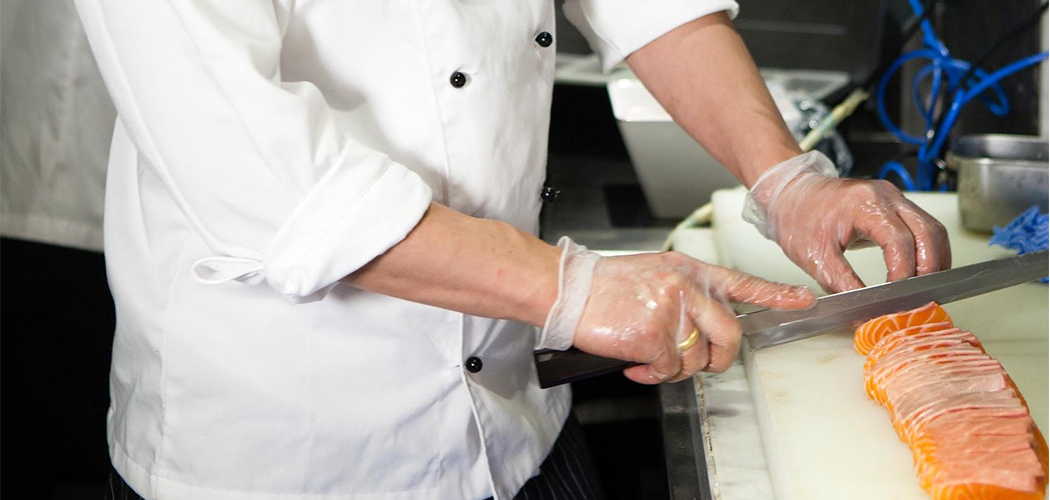When you bite into a delicious piece of sushi you may not realise just how many years of hard work and dedication went into that tiny mouthful. The head chef in a sushi kitchen is a prestigious title that’s taken very seriously.
Here’s everything you need to know about becoming a Japanese sushi master.
Qualities of a great sushi chef
It takes a lot of hard work, skill and creativity to become a good sushi chef.
Think you’ve got what it takes? Some of the top qualities you’ll find in the world’s best sushi chefs include:
1. Cleanliness
If you ever look at the hands of a sushi chef you’ll notice he or she takes good care of them. Their nails will be short and there’ll be no scars visible on their hands. When working in a sushi bar, your hands are on display for customers and no customer wants to see a dirty pair of hands handling their food. World famous sushi chef, Jiro Ono, actually wears gloves on his hands 365 days a year to avoid sunburn and ensure his hands are presentable.
Apart from their hands, sushi chefs will also ensure their hair is neat, their face is clean-shaven and their shirt is wrinkle-free. This is based on the belief that absolute cleanliness speeds your workflow and ensures the food created tastes just right.
2. Expert knife skills
Expert knife skills are absolutely essential to a sushi chef’s ability to cut fish. The aim of sushi chefs is to bring out the best pieces of the fish, so the cutting must be precise. Fish is so delicate so handling it without care can affect the way it tastes.
And just as important as his or her knife skills is how well a sushi chef takes care of his or her knives. Many chefs will sharpen their knife every single day, even twice a day. The amount of attention a chef pays to their knives can reflect the amount of attention they pay to the food they create.
3. Taking your art seriously

Kobe Jones Sushi Chef James Bae at work
Jiro Ono once said, ‘A great chef must eat the best, so that they always have better taste than their customers’. This opens up one’s mind and fills it with ideas and inspiration that can then be channelled into your work. It’s easy to think of art and food preparation as a hobby, but for sushi chefs it’s a serious business. With the art you create, you have the power to evoke joy in people.
How to become a sushi chef
In Japan, the position of ‘itamae’ (head sushi chef) is an extremely prestigious position that’s not easily obtained. It takes years of hard work and training to move up the ranks.
1. Getting started
Every itamae started out their career as a kitchen apprentice. You can learn sushi preparation in school, but the best way to learn is on the job, starting at the bottom and working your way up. School training is limited in that it cannot teach a student the intense devotion and discipline required to be a masterful sushi chef. To learn to work hard, apprentices will begin their journey on cleaning duty. This duty will include washing, scrubbing and general clean up. Once an apprentice proves their devotion to cleaning, they will be assessed for promotion.
2. Rice preparation
Preparing the sushi rice is a sacred job as it requires precision and is often a closely guarded secret. Therefore, this task is only trusted to certain people. The student will learn how to make the rice, carefully blending it with vinegar and salt under close supervision of the itamae. If the student demonstrates that they can consistently make high quality rice without supervision they will find themselves promoted to the position of wakiita.
3. Wakiita
The term ‘wakiita’ means ‘close to the chopping board’. At this point, a student has worked their way up the ladder of the sushi kitchen and is one step beneath coming a fully qualified itamae. However, although they’re nearly there, it may take years of working in this position before they progress from working as a wakiita to an itamae.
The wakiita is responsible for things like grating ginger, preparing wasabi, fish and scallions, and sometimes they’ll even be allowed to help prepare sushi takeaway orders. They’re also finally be allowed to wield their own professional sushi knives (‘hocho’) – a big achievement in the world of sushi.
Being allowed to use hocho is a sign that you’ve earned the trust of the itamae. Hocho come in a wide range of sizes and shapes and are specifically designed for slicing certain sushi ingredients. Check out this sushi and sashimi guide for all the different types and preparation.
The different types of knives include:
- Tako hiki – a knife with a rectangular end.
- Yanagiba – a knife with a pointed end.
- Fugu hiki – a knife with a thin and flexible blade.
- Oroshi hocho – a knife up to 2 metres in length which is used for filleting large tuna.
4. Itamae
After years of gruelling training in the sushi kitchen, a student can finally become a master itamae. As well as having years of experience, a master itamae needs to be good at interacting with customers and will have developed his or her own unique style to bring to the kitchen.
A masterful art
Preparing sushi is more than meets the eye. Years of training, hard work and discipline goes into becoming a head sushi chef. To experience to intricate art of sushi for yourself, check out the all you can eat sushi at Kobe Jones.






 (5 votes, average: 4.80 out of 5)
(5 votes, average: 4.80 out of 5)